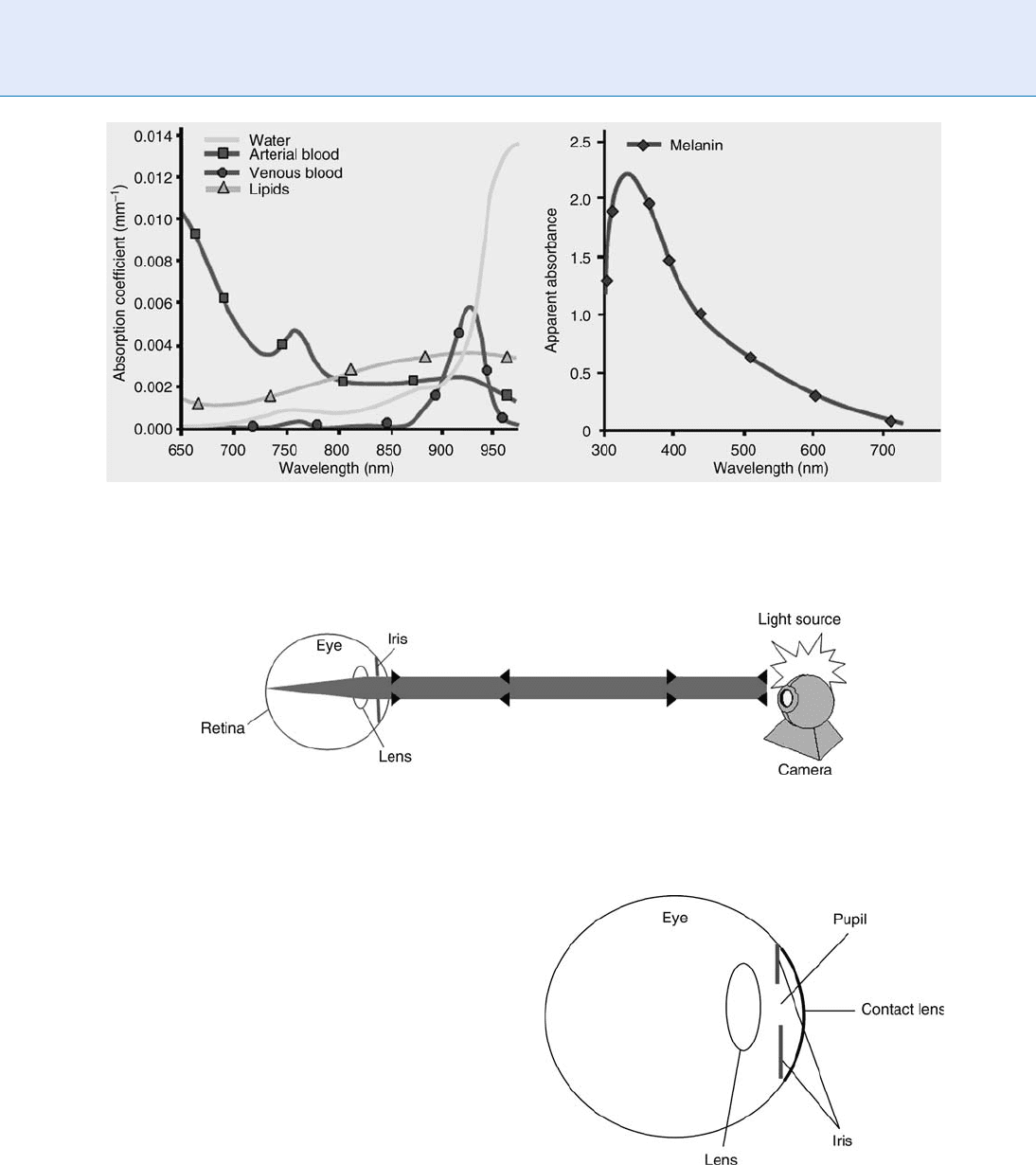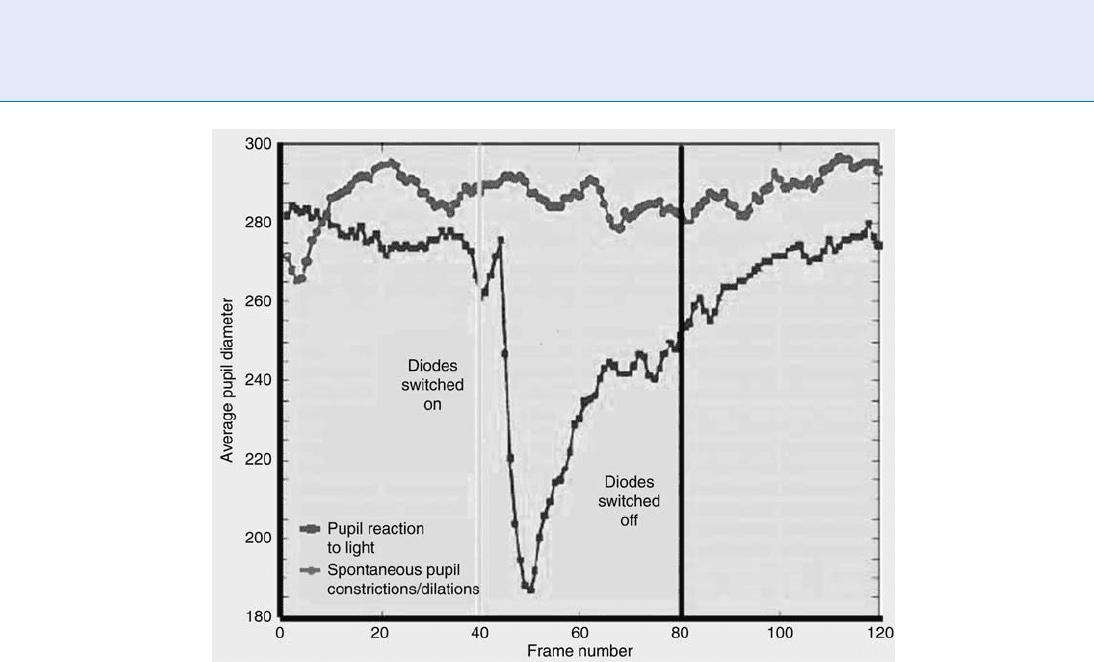Li S.Z., Jain A.K. (eds.) Encyclopedia of Biometrics
Подождите немного. Документ загружается.


the pulse oximetry measurement. This goes beyond
the performance of the liveness algorith m de-
scribed above, because it requires assessment of
spoofing approaches that have yet to be replicated
in the database used to test the liveness algorithm.
Summary
In summar y, liveness systems are being suggested to
reduce the vulnerability due to spoofing. Liveness
measures have an inherent performance, that is, abil-
ity to separate spoof and live attempts. In addition,
liveness algorithms have other factors and considera-
tions including ease of use, collectability, user accep-
tance, universality, uniqueness, permanence, and
spoof-ability. One factor, which is difficult to mea-
sure is spoof-abilit y, the possibility that the liveness
measure can be spoofed. In this c hapter, the term
liveness is used, fully acknowledging that it is not a
perfect system and that it is not possible to recreate a ll
possible spoof a ttempts for a sy stem. Furthermore,
there may be measurements, which rule out specific
spoofs b ut cannot be shown to a bsolutel y mea sure
liveness. For example, algorit hms may be designed
which may readily detect silicon, b ut not gelatin,
spoof images. In summary, it is unlikely that any
system w ill perfectly measure liveness and be spoof-
proof.Livenessmaybeboileddowntoanattemptto
stay one step ahead of those intending to defeat the
system through s poof a ttacks. Methods such as live-
ness or antispoofing are critical to the security and
credibility of biometric systems to p rotect them from
security vulnerabilities to the degree needed for a
particular application.
Related Entries
▶ Liveness Iris
▶ Security and Liveness
References
1. Matsumoto, T., Matsumoto, H., Yamada, K., Hoshino, S.: Im-
pact of artificial ‘gummy’ fingers on fingerprint systems. Proc.
SPIE 4677, 275–289 (2002)
2. Schuckers, S.A.C.: Spoofing and anti-spoofing measures. Inform
Security Tech Rep 7(4), 56–62 (2002)
3. Valencia, V., Horn, C.: Biometric liveness testing. In: Woodward
J.D. Jr., Orlans, N., Higgins M.R.T. (eds.) Biometrics. McGraw-
Hill, Osborne Media, New York (2002)
4. Schuckers, S.A.C., Abhyankar, A.: A wavelet based approach to
detecting liveness in fingerprint scanners. Paper presented at the
Proceedings of Biometric Authentication Workshop, ECCV,
Prague, May 2004
5. Coli, P., Marcialis, G.L., Roli, F.: Power spectrum-based finger-
print vitality detection. Paper presented at IEEE Workshop on
Automatic Identification Advanced Technologies AutoID
pp. 169–173 (2007)
6. Coli, P., Marcialis, G.L., Roli, F.: Vitality detection from finger-
print images: A critical survey. Adv. Biometrics 4642, 722–731
(2007)
7. Biel, L., Pettersson, O., Philipson, L., Wide, P.: ECG analysis:
A new approach in human identification. IEEE Trans. Instrum.
Meas. 50(3), 808–812 (2001)
8. Kallo , P., Kiss, I., Pod manicz ky, A., Talosi, J.: Detector for recognizing
the living character of a finger in a fingerprint recognizing apparatus.
Dermo Corporation, U .S. Patent No . 6,175,64. 16 Jan 2001
9. Baldisserra, D., Franco, A., Maio, D., and Maltoni, D.: Fake
fingerprint detection by odor analysis. Paper presented at the
proceedings of International Conference on Biometric Authen-
tication (ICBA06), Hong Kong, Jan 2006
10. Nixon, K.A., Rowe, R.K.: Spoof detection using multispectral
fingerprint imaging without enrollment. Paper presented at the
Proceedings of Biometrics Symposium (BSYM2005), Arlington,
VA, 19–21 Sept 2005
11. Chen, Y., Jain, A., Dass, S.: Fingerprint deformation for
spoof detection. Paper presented at the Proceedings of
Biometrics Symposium (BSYM2005), Arlington, VA, 19–21
Sept 2005
12. Antonelli, A., Cappelli, R., Maio, D., Maltoni, D.: Fake finger
detection by skin distortion analysis. IEEE Trans. Inform. For-
ensics Security 1(3), 360–373 (2006)
13. Jia, J., Lianhong, C., Kaifu, Z., Dawei, C.: A new approach to fake
finger detection based on skin elasticity analysis. Adv. Biometrics
4642, 309–318 (2007)
14. Zhang, Y., Tian, J., Chen, X., Yang, X., Shi, P.: Fake finger
detection based on thin-plate spline distortion model. Adv.
Biometrics 4642, 742–749 (2007)
15. Derakhshani, R., Schuckers, S., Hornak, L., O’Gorman, L.:
Determination of vitality from a non-invasive biomedical mea-
surement for use in fingerprint scanners. Pattern Recogn. 17(2),
383–396 (2003)
16. Schuckers, S.A.C, Derakhshani, R., Parthasardhi, S., Hornak,
L.A.: Liveness detection in biometric devices. In: Electrical
Engineering Handbook, Chapter 26, 3rd edn. CRC, Boca
Raton (2006)
17. Parthasaradhi, S., Derakhshani, R., Hornak, L., Schuckers,
S.A.C.: Time-series detection of perspiration as a liveness test
in fingerprint devices. IEEE Trans. Systems Man Cybern C Appl
Rev 35, 335–343 (2005)
18. Tan, B., Schuckers, S.: Liveness detection using an intensity
based approach in fingerprint scanner. Paper presented at Pro-
ceedings of Biometrics Symposium (BSYM2005), Arlington, VA,
19–21 Sept. 2005
930
L
Liveness Detection: Fingerprint

19. Moon, Y.S., Chen, J.S., Chan, K.C., So, K., Woo, K.C.: Wavelet
based fingerprint liveness detection. Electron. Lett. 41(20),
1112–1113 (2005)
20. Jin, C., Kim, H., Elliott, S., Liveness detection of fingerprint
based on band-selective fourier spectrum. Information Security
Cryptol –ICISC, vol. 4817, pp. 168–179. Springer, Berlin (2007)
21. Tan, B., Schuckers, S.: A new approach for liveness detection in
fingerprint scanners based on valley noise analysis. J. Electron.
Imag. 17(1), 011009-1–011009-9 (2008)
22. Jia, J., Lianhong, C.: Fake finger detection based on time-series
fingerprint image analysis. In: Advanced Intelligent Computing
Theories and Applications. With Aspects of Theoretical and
Methodological Issues, vol. 4681, pp. 1140–1150. Springer,
Berlin (2007)
23. Abhyankar, A., Schuckers, S.A.C.: Characterization, similarity
score, and uniqueness of fingerprint perspiration patterns.
In: Kanade et al. (eds.) et al.: Proceedings of Audio- and
Video-Based Biometric Person Authentication: 5th International
Conference. Lecture Notes in Computer Science, vol. 3546,
pp. 860–868. Springer, Berlin (2005)
Liveness Detection: Iris
BORI TOTH
Deloitte & Touche LLP, London, UK
Synonyms
Anti-spoofing; Spoofing countermeasures; Spoof -
resistance; Vitality tests
Definition
Iris liveness detection techniques are designed to coun-
teract physical
▶ spoofing attack s launched against iris
recognition systems. Such attacks include the use of
photographs, video recordings, printed contact lenses
etc. Iris liveness detection mechanisms aim to ascertain
that iris images acquired were acquired from a live and
authorized user present at the time of transaction.
Introduction
Iris recognition systems are among the most accurate
biometric systems available today. Additionally, the iris
is an internal organ which makes it more robust to
spoofing attacks when compared to some of the other
biometric technologies, especially fingerprinting. This
is mainly due to two reasons. Firs t, unlike DNA and
fingerprints, individuals do not leave traces of their
irises behind which could be lifted and copied. Second,
it is more difficult to manipulate an internal organ
than to di sguise an external body part such as
the face. Nevertheless, all technologies have inherent
weaknesses which can be exploited, including iris
recognition.
On the one hand, privacy experts argue that bio-
metric information is private. Additionally, the grow-
ing uptake of large-scale biometric systems worldwide
intensifies the fear of hackers stealing biometric infor-
mation from centralized databases. On the other hand,
it is a fact that the acquisition of biometric information
is much easier than breaking datab ases. Facial images
are being taken via public and private CCTV systems
day and night: think of ATMs, petrol stations, banks,
and airports just to name a few places were camera
surveillance systems are usually in 24/7 operation. The
situation is similar for most other biometric traits: we
leave our fingerprints and DNA behind on every sur-
face we touch and phone-based service providers usu-
ally record our voices during phone calls [1]. In the
case of iris recognition, a high resolution image of
someone’s eye can be sufficient to make the technology
work. CCTV image quality might often be too poor
to extract iris images of sufficient quality but this is
merely a hardware question.
We have to accept that our facial and eye images,
voice patterns, fingerprints, and DNA etc. are publicly
available. It has already been shown, through various
experiments that many if not all biometric technolo -
gies including iris recognition are susceptible to spoof-
ing attacks: biometric identifiers can be copied
and used to create some
▶ artifacts that can deceive
several biometric devices available today (
▶ Security
and Liveness, Overview).
Therefore, the question is not whether biometrics
can be copied and forged but rather whether devices
can perform accurate liveness testing. The aim of live-
ness testing is to determine if the biometric data
is being captured from a legitimate, live user who is
physically present at the point of acquisition. This
is especially cruc ial for remote authentication services
performed over open networks where neither the end
user’s terminal nor the data transmission channels can
Liveness Detection: Iris
L
931
L

be controlled by system operators. An increasing num-
ber of vendors are implementing liveness testing into
their biometric devices, to guard against the threat
of spoofing attacks. However, spoofing-related issues
remain unknown to many [2].
Risks of Biometric Spoofing
In order to understand security mechanisms such as
liveness detection, it is important to analyze the inher-
ent risks and weaknesses first. Like any other security
technolog y, biometrics also have inherent weaknesses
that can potentially lead to security breaches. Suscepti-
bility to spoofing attacks is just one possible weakness
inherent to biometric readers (
▶ Biometrics Vulner-
abilities: Overview).
Biometric spoofing attacks can be either digital or
physical. Digital attacks are defended against by
authenticating the biometric reader sending the data
and eliminating vulnerable data paths; liveness testing
methods are not applicable in this case. Hence this type
of vulnerability is not being discussed any further in this
article. Physical spoofing of a biometric credential refers
to the attack whereby an adversary copies a legitimate
biometric to generate a fake artifact and tries to gain
access to the system using this artifact. Spoofing attacks
may be undertaken with the cooperation of the legiti-
mate user, in an effort to delegate access rights, or
without user knowledge by collecting iris pictures from
iris recognition systems and infrared cameras, or facial
images from camera and surveillance equipment [2].
A biometric system can be used in an access control
scenario, either logical or physica l, or as a watch list
application to detect and identify particular ‘‘wanted’’
individuals. In each case, the purpose of the system and
the risks of spoofing are different:
1. In an access control scenario, the system keeps a
register of authorized users. An example of such a
system is the voluntary, fully-automated immigra-
tion control system, IRIS, which operates at several
major airports in the UK. In such a scenario, fake
iris artifacts could be used to:
a. Mount attacks against existing enrolments in
order to gain unauthorized access – either logi-
cal or physical – to the resources protected by
the iris recognition system and/or to fraudu-
lently associate an audit trail with an unwitting
individual
b. Enroll into the iris system and then delegate
these artifacts across multiple individuals,
undermining the integrity of the system
c. Additionally, a legitimate user could try to re-
pudiate transacti ons associated with his account
or enrolment, claiming instead that they are the
result of attacks, due to the inability of the
biometric system to ensure liveness
2. In a watch list application, the system keeps a
record of people who are being sought by the
authorities or who are to be unequivocally denied
access to the assets or facilities protected by the
biometric device. An examp le of such a system is
the iris-based border control system operated by
United Arab Emirates’ authorities. In such a setup,
it is of course preferable from a registered person’s
point of view not to be recognized by the system. In
connection to the watch lists , an iris artifact could
be used to:
a. A bogus enrolment record can be created so that
the wanted/unauthorized person could contin-
ue to use the system with his real irises without
being detected
b. A wanted person’s iris patterns can be imitated
to lead authorities to think (even just temporar-
ily) that someone from the watch list had been
caught
c. A wanted person’s iris patterns can be disguised
(which had been previously registered in the
system) avoid identification and/or gain unau-
thorized access.
Note that the goals of the
▶ impostor are different
in these two scenarios: for access lists, it’s about imper-
sonating a legitimate user, while for the watch lists, it’s
about disguising one’s identity. The latter is believed to
be a much easier task, i.e., it is easier to disguise one’s
iris patterns so that they cannot be recognized anymore
than to imitate someone else’s iris patterns so closely
that a match is achieved.
Spoof-resistance Testing
Governments, academics and an increasing number of
industry players are active in the space of testing the
resilience of biometric systems against spoofing. While
vendors and governments tend to keep their results
secret, several test methods and results were published
in recent years by the academics and consultants.
932
L
Liveness Detection: Iris

In 2002, a report was published by the German
Fraunhofer Research Institute, detailing results of
much earlie r spoofing experiments on face, finger,
and iris systems which they carried out in cooperation
with t he German Federal Institute for Information
security (BSI) [3]. This report was among the first to
raise a few eyebrows about the security of biometric
systems available at that time.
A 2002 issue of c’t magazine [4] followed by the
description of further attacks. Alongside several other
biometric technologies, the authors were able to spoof
a low-cost iris recognition device using high-resolution
eye images with cut out holes for the pupil which they
placed in front of a real eye.
A well-known authority in spoofing, Professor Tsu-
tomu Matsumoto of Yokohama National University in
Japan, has published the results of two iris spoofing
rounds so far. In 2004, he spoofed three iris recognition
cameras with high-resolution photographs with cut
out holes for the pupil placed in front of a real eye
[5]. Only one of the iris systems did not accept the
fake iris for enrolment, but all devices could be spoofed
during verification. In 2007, Professor Matsumoto
presented another spoofing method using metallic riv-
ets with shiny black rounds heads and printed iris
images [6, 7].
Much research has gone into analyzing the effec-
tiveness of spoofing of contact lenses with printed or
hand-painted iris patterns as well. In addition to
printed photographs and printed/painted contact
lenses, other artifacts which could be used to physically
spoof iris devices include screen images, video record-
ings, and artificial eyes (glass, plastic etc.).
Liveness Detection Mechanisms
Biometric experts have been actively researching meth-
ods to counter the threat of physical spoofing of bio-
metric samples for more than a decade now. In
particular, various liveness detection methods have
been conceived and indeed implemented in some
devices. However, as every man-made solution can be
defeated, efforts are ongoing in this area.
System supervision is the first line of defense
against spoofing. The use of several types of spoofing
artifacts becomes inconvenient if not impossible,
if a human supervisor is present at the point of iris
image acquisition. Such examples include the use of
photographs or video recordings. Human operators
can also detect printed or painted lenses but the costs
and inconvenience of such a process make its day-to-
day use prohibitive. Additionally, human performance
is affected by many factors including tiredness, moti-
vation, sickness etc.
Automate d liveness detection can be performed in
a biometric device either at the acquisition or proces-
sing stage. It usually involves enhancements to soft-
ware and/or hardware. The presented set of method s is
not an exclusive list; however, examples are given for
each iris liveness detection category. Automated live-
ness detection techniques measure and ana lyze one of
the following three characteristics [8].
Intrinsic properties of a living body
Methods belonging in this category, analyze static
characteristics of the material presented to the biomet-
ric reader. Such characteristics include densit y and
elasticity (physical properties), capacitance, resistance
and permittivity (electrical properties), reflectance and
absorbance (spectral properties), color and opacity
(visual properties), and chemical content analysis
in fluids.
Spectrographic properties of tissue, fat, blood, and
pigment can be used to test for liveness in irises.
Figure 1 shows that different components of living
tissue have distinctive spectrographic signatures. Com-
paring the fractions of light reflected in 300–1000 nm
bandwidth can reveal these spectrographic signatures
[9]. If the iris presented to the system is a glass eye, a
photograph, or dead tissue, spectrographic analyses
could help in detecting the spoofing attack. In fact,
ink and paper used to create photographic printouts
are often completely ineffective in near-infrared
light, which is used during the acquisition of iris
images [11].
Retinal light reflections commonly known as the
‘‘red-eye effect’’ can also be used to detect liveness of
the eye. Essentially, light entering the eye is reflected
back to the light source by the retina; this effect can be
captured by a camera. Functional eye cavity optics
make the eye to appear red of the pigment (cal led
retinal or visual purple) in the photoreceptors
of the retina (Fig. 2). Red-eye effect will occur if the
angle between light source, eye and camera is smaller
than 2.5
[10].
Liveness Detection: Iris
L
933
L

The iris is a relatively flat internal organ, located
behind the cornea and in front of the lens. When a
printed or hand-painted contact lens is placed over the
eye, the fake ‘‘iris’’ is floating over an external, round
surface, the cornea (Fig. 3). Therefore, another intrinsic
property for which iris devices can scan is the 3D nature
of the layer containing the iris patterns acquired.
In a natural eye, four optical surfaces reflect light:
the front and back surfaces of the cornea as well as the
front and back surfaces of the lens (Fig. 4). These
reflections are also referred to as Purkinje reflections
or images, named after a Czech physiologist. The front
surface of the cornea produces the brightest reflection
while the back of the lens produces the weakest one.
The position of the reflected light determines the posi-
tion of the reflections – another intrinsic property
which can be used to distinguish between natural
Liveness Detection: Iris. Figure 1 Light-reflecting properties of different components of living tissue can help to detect
iris-spoofing attempts [2, 9, 10].
Liveness Detection: Iris. Figure 2 The ‘‘red-eye effect’’ – the retina reflects the light entering the eye back to the light
source [10].
Liveness Detection: Iris. Figure 3 Contact lenses with
fake iris patterns float over the curved external surface of
the eye whereas the iris is lying in an internal plane inside
the eye.
934
L
Liveness Detection: Iris

eyes and fake artifacts. A change in the location of the
light source should therefore even screen out photo-
graphs displaying Purkinje reflections [11]. It might be
difficult to capture all four Purkinje reflections at all
times due to their varying strength; however, it could
be sufficient to analyze the strongest reflections coming
from the outer layer of the cornea. Varying positions of
near-infrared lig ht diodes used during image acquisi-
tion could also be used to analyze this property of the
living eye.
John Daugman, the inventor of iris recognition,
has also pointed out that the printing process itself
can leave detectable traces on spoofing lenses [11].
A 2D Fourier analysis of the acquired image can show
off traces of printing, as demonstrated in Fig. 5. Pacut
and Czajka have developed automated methods
to analyze artificial frequencies in printed iris images.
One great advantage of this method is that, it does
not require any additional hardware; it merely analyzes
the iris image already captured. However, according
to Shanon’s theory, the method has a drawback:
it fails once the resolution of the printing device
is higher than twice the resolution of the analysis
camera [12].
Involuntary signals of a living body
Living tissue involuntarily displays dynamic signals
which are measurable. These signals can be attributed
Liveness Detection: Iris. Figure 4 A picture of a natural
eye displaying Purkinje reflections.
Liveness Detection: Iris. Figure 5 2D Fourier analysis extracts remnants of the printing process on a contact lens.
Liveness Detection: Iris
L
935
L

to the nervous system and include pulse, blood pres-
sure, pupillary unrest (hippus), perspiration, blood
flow, brain wave signals (EEG), and electrical heart
signals (ECG or EKG).
Daugman mentioned the idea of using involuntary
signals of the body to measure liveness detection in
iris recognition schemes in several of his papers.
A very interesting yet little known involuntary signal
generated by the human body is the hippus, which is
a pupillary steady-state oscillation at about 0.5 Hz,
occurring in eyes without any changes in illuminat-
ion. The coefficient of variation is at least 3% [11],
although it declines with advancing age. This liven-
ess detection technique can effectively be used
to screen out prosthetic eyes, high-resolution
photographs, or dead tissue. The upper graph (with
round dots) in Fig. 6 shows involuntary changes in
pupil size.
▶ Iris recognition algorithms need to track the
inner and outer boundaries of the iris anyway as part
of the extraction process so tracking the changes of
pupil size as well as eyelid movements are relatively
easy liveness detection methods to implement.
Bodily responses to external stimuli
Finally, it is possible to measure dynamic bodily
responses to external stimuli. These liveness detection
methods are challenge-response techniques that either
look for voluntary (behavioral) responses or involun-
tar y (reflexive) ones.
Behavioral challenge-response methods require
user cooperation. As an example, the spoofing resis-
tance of iris recognition products can be enhanced by
prompting the user to blink or look left and right, and
up and down. If the signal presented to the system is a
photograph or video recording, the system is likely to
recognize these as fakes.
For iris recognition, an involuntary reflex of the body
can be easily triggered by changing illumination levels. The
pupil can be driven larger or smaller by changes in lighting
conditions, with a response time constant of about
250 ms for constriction and about 400 ms for dilation
[11]. The lower graph (with square dots) in Fig. 6 shows
the pupillary reflex as a diode is switched on and off.
Another interesting effect which can be observed
when the pupil size changes is the nonelastic distortion
Liveness Detection: Iris. Figure 6 Spontaneous pupil size variations with (square dotted line) and without (round dotted
line) any changes in lighting levels [2, 12].
936
L
Liveness Detection: Iris

of the iris tissue itself. Contact lenses or photographs
won’t be able to imitate this process.
The Effectiveness of Liveness Testing
Methods
Some of the above presented methods have been tested
independently with very promising results [3]. How-
ever, there is a need for a consistent testing framework
to assess the effectiveness of liveness testing methods
and market iris products on an ongoing basis. Schemes
have been proposed by both the academia and industry
[3, 7, 13, 14] but there is still no consensus over
an in ternationally standardized spoof-resistance test-
ing methodology.
The Trade-off between Security and
Convenience
Biometric devices should only be spoof-protected to a
level corresponding to the nature of operations (i.e.,
depending on whether operations are mainly security-
or convenience-focussed) due to the following limita-
tions of liveness detection methods [2]:
Firstly, there is a conjecture that for all biometrics,
the problem of confirming the vitality of a sample
(‘‘liveness testing’’) is more difficult than to make
decisions about matches between templates. The
two distributions of similarity generated by ‘‘genu-
ine’’ and ‘‘spoof’’ samples for the same person are
likely to be closer and to have more overlap in the
vitality test than the two distributions that are
generated in a template matching test by ‘‘same’’
and ‘‘different’’ persons without any spoofing effort
[9]. In other words, liveness testing can adversely
affect recognition performance (‘‘Security and
Liveness, Overview’’).
Secondly, liveness tests have the propensity to in-
crease the time to acquire the biometric sample,
thus reducing user convenience.
Finally, the incorporation of liveness tests into a
device usually also means increasing hardware/
software costs.
Summary
Spoofing is a real concern with regards to the secur ity
of biometric systems. More and more successful spoof-
ing attempts are being published and even though the
sophistication of these attacks is on the rise, spoofing is
still in its infancy. In particular, contact lenses with
hand-painted and printed iris patterns are expected
Liveness Detection: Iris. Table 1 Overview of discussed liveness detection methods for iris recognition with an
indication of their effectiveness
Category Countermeasure Targeted artifacts
Extraction of intrinsic
properties (static)
Spectrographic analysis All
Near-infrared illumination All involving inks and dyes
Red-eye effect All except patterned contact lenses
3D curvature of iris surface Patterned contact lenses
Purkinje reflections All except patterned contact lenses
Frequency spectrum analysis Printed artifacts
Analysis of involuntary
signals (dynamic)
Pupillary unrest (hippus) All except patterned contact lenses which only
party cover the real iris
Eyelid movements All except patterned contact lenses
Challenge-response
methods (dynamic)
Eye movements (blinking, looking in
various directions)
All except patterned contact lenses
Pupillary light reflex All except patterned contact lenses which only
party cover the real iris
Nonelastic distortion of iris tissue All
Liveness Detection: Iris
L
937
L

to pose an in creasing threat due to enhancements of
ink quality and printing technologies. Furthermore,
patterned lenses are relatively di fficult to detect when
compared to some of the other spoofing methods.
Both the industry and academia are focusing their
efforts to make biometric dev ices more robust but
every countermeasure can eventually be circumvented.
Thus research and development efforts must be
ongoing.
This article illustrates that it is possible to combat
physical spoofing attacks with liveness testi ng (Table 1)
but all of these countermeasures come at a certain
price, often affecting user convenience, system prices,
or matching accuracy. Therefore, it is crucial to select a
device that incorporates spoofing countermeasures to
a level of sophistication and effectiveness that matches
the requirements of the application.
As spoofing techniques are swiftly evolving and
countermeasures have only a limited life cycle, in addi-
tion to the necessary research and development efforts
it is of great importance to perform standardized,
vendor-independent tests of robustness and to assess
on a regular basis the overall level of security provided
by biometric systems.
Related Entries
▶ Anti-spoofing
▶ Liveness Detection
▶ Spoofing; Biometric Vulnerabilities
References
1. Toth, B.: Biometric ID card debates. ‘‘Biometrie’’ Newsletter of
ISACA Chapter Switzerland, Germany and Austria (2005)
2. Toth, B.: Biometric Liveness Detection. Information Security
Bulletin, ISB1008, CHI Publishing 291–297 (2005)
3. Czajka, A., Strzelczyk, P., Pacut, A.: Making iris recognition more
reliable and spoof resistant. SPIE Newsroom, doi: 10.1117/
2.1200706.0614 (2007)
4. Thalheim, L., Krissler, J., Ziegler, P-M.: Body Check. Biometric
Access Protection Devices and their Programs Put to the Test, c’t
Magazine (2002)
5. Matsumoto, T.: Artificial fingers and irises: Importance of vul-
nerability analysis. In: Proceedings of the 7th International
Biometrics Conference, London. Elsevier (2004)
6. Matsumoto, T., Kusuda, T.: IECIE Technical Report on
Biometrics Security (2007)
7. Matsumoto, T.: Assessing the security of advanced biometric
systems: Finger, vein and iris. In: Proceedings of the 10th Inter-
national Biometrics Conference, London. Elsevier (2007)
8. Woodward, J.D., Orlans, J.M., Higgins, P.T.: Biometrics. Identity
Assurance in the Information Age, Osborne McGraw-Hill
Osborne Media Berkeley, California, USA (2003)
9. Daugman, J.G.: Iris recognition and anti-spoofing countermea-
sures. In: Proceedings of the 7th International Biometrics Con-
ference, London. Elsevier (2004)
10. Toth, B.: Liveness detection for iris recognition, In: Proceedings
of Biometrics and E-Authentication over Open Networks, NIST
Gaithersburg (2005)
11. Daugman, J.G.: Recognizing persons by their iris patterns:
Countermeasures against subterfuge. In: Jain, A.K., et al. (eds.)
Biometrics: Personal Identification in a Networked Society, Kluwer
Academic Publishers, Dordrecht, The Netherlands(1999)
12. Pacut, A., Czajka, A.: Liveness detection for iris biometrics. In:
Proceedings of 40th IEEE International Carnahan Conference
on Security Technology, Lexington, KY. IEEE (2006)
13. Dunstone, T.: Current Status of Biometrics in Australia and
New-Zealand including Vulnerability Assessments. In: Proceed-
ings of the 10th International Biometrics Conference, London.
Elsevier (2007)
14. Nanavati, S.: Spoofing Biometrics: Deploying Imperfect
Biometrics. In: Proceedings of the 10th International Biometrics
Conference, London. Elsevier (2007)
Live-Scan Furrow Device
It refers to a device, able to read the ridge-valley pat-
tern present on finger tips, palms, and foot soles. It can
be considered as a generic name grouping all the fin-
gerprint, palmprint, handprint, and soleprint devices.
▶ Fingerprint, Palmprint, Handprint and Soleprint
Sensor
Live-Scan Sensor
A live-scan sensor is a sensor that allows to capture and
digitize biometric data in real time. As opposed to live-
scan acquisition, in off-line acquisition, data is not
digitized in real time (e.g., a fingerprint image is first
obtained by smearing ink on the fingertip and creating
938
L
Live-Scan Furrow Device

an inked impression on paper, and the inked impres-
sion is digitized by scanning the paper).
▶ Fingerprint Databases and Evaluation
Local Adaptive Thresholding
Local adaptive thresholding is used to convert an
image consisting of gray scale pixels to just blac k and
white scale pixels. Usually a pixel value of 0 represents
white and the value 255 represents black with the
numbers from 1 to 254 representing different gray
levels. Unlike the global thresholding technique, local
adaptive thresholding chooses different threshold
values for every pixel in the image based on an analysis
of its neighboring pixels. This is to allow images with
varying contrast levels where a g lobal thresholding
technique will not work satisfactorily. There are a
number of different forms of adaptive thresholding
algorithm reported in the image processing literature.
▶ Hand Vein
Local Descriptors
▶ Local Image Features
Local Fusion
Local fusion in the framework or multi-biometric
score fusion refers to user-specific score fusion t echni-
ques in which each fusion function is trained based
exclusively on data associated with the claimed user
(both genuine and impostor scores).
▶ Fusion, User-Specific
Local Image Features
KRY S T I A N MIKOLAJCZYK
1
,TINNE TUYTEL AARS
2
1
School of Electronics and Physical Sciences,
University of Surrey, Guildford, Surrey, UK
2
Department of Electrical Engine ering, Katholieke
Universiteit Leuven, Kasteelpark Arenberg 10, Leuven,
Belgium
Synonyms
Interest points; Keypoints; Local descriptors
Definition
A ▶ local feature is an image pattern which differs from
its immediate neighborhood. It is usually associated
with a change of an image property or several proper-
ties simultaneously, though it is not necessarily loca-
lized exactly on this change. The image properties
commonly considered are intensity, color, and texture.
Figure 1 shows some examples of local features in a
contour image (left) as well as in a grayvalue image
(right). Local features can be points, but also edgels or
small image patches. Typically, some measurements are
taken from a
▶ region centered on a local feature and
converted into descriptors. The descriptors can then be
used for various applications. Three broad categories
of feature
▶ detectors can be distinguished based on
their possible usage. It is not exhaustive or the only way
of categorizing the features but it emphasizes different
properties required by the usage scenarios. First, one
might be interested in a specific type of local features,
as they may have a specific semantic interpretation in
the limited context of a certain application. For in-
stance, edges detected in aerial images often corre-
spond to roads; blob detection can be used to
identify impurities in some inspection task; etc. These
were the first applications for which local feature
detectors have been proposed. Second, one might be
interested in local features since they provide a limited
set of well localized and individually identifiable an-
chor points. What the features actually represent is not
really relevant, as long as their location can be deter-
mined accurately and in a stable manner over time.
This is for instance the situation in most matching
or tracking applications, and especially for camera
Local Image Features
L
939
L
